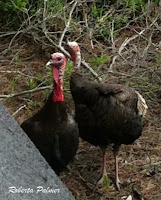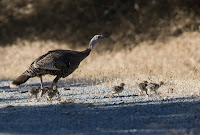WILD TURKEY
WILD TURKEY – (Meleagris gallopavo) – (See images below)
DESCRIPTION: The Wild Turkey male is mostly black or dark grey. The head and neck are bare. The head is white and the neck red. The bill is pink. The rump is black, and the tail has bands of beige, brown and black. Females (hens) are largely mottled brown overall. The legs are pinkish grey. It is a large bird at around 1.1 meter (43 in.) long and can weigh up to 10 kg (22 lb) in males, which are larger than females.
VOICE: https://www.xeno-canto.org/species/Meleagris-gallopavo
NAME: The name ‘Turkey’ seems to refer to an identification error a few centuries ago when some wild turkeys were sent to Britain via Turkey. The name ‘wild’ has been attributed to this bird to distinguish it from the domestic turkey. The Latin genus name ‘Meleagris’ means a ‘Guineafowl’, and the Latin species name ‘gallopavo’ derives from ‘gallus’ (a cock), and ‘pavo’ (a peafowl).
HABITAT: Open forest.
DIET: Wild turkeys prefer tree nuts and acorns, but also eat seeds, berries, insects and other small animals.
BREEDING/NESTING: Males gather a harem of females and will display for them with the tail open in a fan-like fashion and the wings trailing on the ground. The nest is a shallow depression on the ground in a well-hidden area. An average of nine beige eggs are laid, which are incubated by the female. The chicks (poults) are cared for by the female.
DISTRIBUTION: Wild turkeys do not migrate. They are now established in all lower USA states.
Distribution map: https://en.wikipedia.org/wiki/Wild_turkey#/media/File:Wild_Turkey.png
ON HAWAII: The first wild turkeys to be introduced to Hawaii arrived in 1815. There are now small populations on several of the main islands.
ON PEI: The wild turkey does not appear on the Field Checklist of Birds (8th Edition) 2014 for Prince Edward Island. (The checklist was published by the Prince Edward Island Department of Agriculture and Forestry. Please click on Field Checklist of Birds – 8th Edition – 2014 for a copy of the checklist in .pdf format.) However there have been occurrences of these birds seen in the wild over the years. The PEI government does not allow its release in the wild due to concerns from blueberry & grain farmers. There have also been ‘false rumors’ of wild turkey sightings on the island, for example in the Brookvale area in 2016. Any sighting in the wild should be reported to the Provincial Fish & Wildlife Division by calling 902-368-4700.
CONSERVATION: Wild turkey numbers started declining at some point due to hunting pressure, so wild turkeys were introduced to more USA states – including Hawaii – and southern Canada. Now their numbers are increasing and they are hunted within careful management programs.
NOTES: The Wild turkey is part of the same family as the partridge, the chicken and the pheasant.
It is widely known across North America due to its association with Thanksgiving.
Here are some interesting news and facts on the wild turkey in other provinces and states:
New Brunswick – the provincial government there does not want (yet) the species reintroduced into the province due to concerns from farmers, but some individuals apparently have made their way up north from Maine, and hunters are lobbying for its introduction.
Newfoundland – dozens of those birds were seen in Codroy Valley foraging on corn in farm fields.
Nova Scotia – The province has decided NOT to introduce the wild turkey. Hunters have to travel to New England to hunt the species, but some are working to be able to raise them on reserves for hunting purposes.
Quebec – The provincial government there reintroduced that native species into the Eastern Townships in the 1980s, and since then the population has exploded in spite of hunting, raising concerns from local farmers. A wild turkey has also smashed into a living room window, causing extensive property damage. And a wild turkey tom charged at a player on a golf course on Île Bizard.
Ontario – there are concerns there that reintroduced wild turkey populations are taking their toll on the forest floor by scraping away at the leaf litter and leaving the ground bare on large surfaces, and eating seeds that would be needed to regenerate the forest. Their damage is compared to that of deer on the under story.
A man was followed by a very persistent wild turkey in a Brampton area in March 2018. Ontario would now have a wild turkey population at around 70,000 birds.
British Columbia – In Edgewater, dozens of wild turkeys snap branches when roosting in large groups in trees.
Oregon – wild turkeys can also damage gardens with their scratching and digging for seeds and insects, leaving droppings ‘everywhere’.
REFERENCES: https://www.allaboutbirds.org/guide/wild_turkey/id
https://en.wikipedia.org/wiki/Wild_turkey
https://www.audubon.org/field-guide/bird/wild-turkey
http://www.arkive.org/wild-turkey/meleagris-gallopavo/
http://www.nwtf.org/hunt/category/all-about-wild-turkeys
https://www.mba-aom.ca/jsp/toc.jsp (Maritimes Breeding Bird Atlas)
http://www.nhptv.org/natureworks/wildturkey.htm (New Hampshire PBS)
DESCRIPTION: The Wild Turkey male is mostly black or dark grey. The head and neck are bare. The head is white and the neck red. The bill is pink. The rump is black, and the tail has bands of beige, brown and black. Females (hens) are largely mottled brown overall. The legs are pinkish grey. It is a large bird at around 1.1 meter (43 in.) long and can weigh up to 10 kg (22 lb) in males, which are larger than females.
VOICE: https://www.xeno-canto.org/species/Meleagris-gallopavo
NAME: The name ‘Turkey’ seems to refer to an identification error a few centuries ago when some wild turkeys were sent to Britain via Turkey. The name ‘wild’ has been attributed to this bird to distinguish it from the domestic turkey. The Latin genus name ‘Meleagris’ means a ‘Guineafowl’, and the Latin species name ‘gallopavo’ derives from ‘gallus’ (a cock), and ‘pavo’ (a peafowl).
HABITAT: Open forest.
DIET: Wild turkeys prefer tree nuts and acorns, but also eat seeds, berries, insects and other small animals.
BREEDING/NESTING: Males gather a harem of females and will display for them with the tail open in a fan-like fashion and the wings trailing on the ground. The nest is a shallow depression on the ground in a well-hidden area. An average of nine beige eggs are laid, which are incubated by the female. The chicks (poults) are cared for by the female.
DISTRIBUTION: Wild turkeys do not migrate. They are now established in all lower USA states.
Distribution map: https://en.wikipedia.org/wiki/Wild_turkey#/media/File:Wild_Turkey.png
ON HAWAII: The first wild turkeys to be introduced to Hawaii arrived in 1815. There are now small populations on several of the main islands.
ON PEI: The wild turkey does not appear on the Field Checklist of Birds (8th Edition) 2014 for Prince Edward Island. (The checklist was published by the Prince Edward Island Department of Agriculture and Forestry. Please click on Field Checklist of Birds – 8th Edition – 2014 for a copy of the checklist in .pdf format.) However there have been occurrences of these birds seen in the wild over the years. The PEI government does not allow its release in the wild due to concerns from blueberry & grain farmers. There have also been ‘false rumors’ of wild turkey sightings on the island, for example in the Brookvale area in 2016. Any sighting in the wild should be reported to the Provincial Fish & Wildlife Division by calling 902-368-4700.
CONSERVATION: Wild turkey numbers started declining at some point due to hunting pressure, so wild turkeys were introduced to more USA states – including Hawaii – and southern Canada. Now their numbers are increasing and they are hunted within careful management programs.
NOTES: The Wild turkey is part of the same family as the partridge, the chicken and the pheasant.
It is widely known across North America due to its association with Thanksgiving.
Here are some interesting news and facts on the wild turkey in other provinces and states:
New Brunswick – the provincial government there does not want (yet) the species reintroduced into the province due to concerns from farmers, but some individuals apparently have made their way up north from Maine, and hunters are lobbying for its introduction.
Newfoundland – dozens of those birds were seen in Codroy Valley foraging on corn in farm fields.
Nova Scotia – The province has decided NOT to introduce the wild turkey. Hunters have to travel to New England to hunt the species, but some are working to be able to raise them on reserves for hunting purposes.
Quebec – The provincial government there reintroduced that native species into the Eastern Townships in the 1980s, and since then the population has exploded in spite of hunting, raising concerns from local farmers. A wild turkey has also smashed into a living room window, causing extensive property damage. And a wild turkey tom charged at a player on a golf course on Île Bizard.
Ontario – there are concerns there that reintroduced wild turkey populations are taking their toll on the forest floor by scraping away at the leaf litter and leaving the ground bare on large surfaces, and eating seeds that would be needed to regenerate the forest. Their damage is compared to that of deer on the under story.
A man was followed by a very persistent wild turkey in a Brampton area in March 2018. Ontario would now have a wild turkey population at around 70,000 birds.
British Columbia – In Edgewater, dozens of wild turkeys snap branches when roosting in large groups in trees.
Oregon – wild turkeys can also damage gardens with their scratching and digging for seeds and insects, leaving droppings ‘everywhere’.
REFERENCES: https://www.allaboutbirds.org/guide/wild_turkey/id
https://en.wikipedia.org/wiki/Wild_turkey
https://www.audubon.org/field-guide/bird/wild-turkey
http://www.arkive.org/wild-turkey/meleagris-gallopavo/
http://www.nwtf.org/hunt/category/all-about-wild-turkeys
https://www.mba-aom.ca/jsp/toc.jsp (Maritimes Breeding Bird Atlas)
http://www.nhptv.org/natureworks/wildturkey.htm (New Hampshire PBS)
 |
| Wild turkey hens, photo by Roberta Palmer, Mass., USA |
 |
| Wild turkey in flight, Grendelkhan |
 |
| Wild turkey male displaying photo by Riki7, Jan. 2014 |
 |
| Wild turkey hen and chicks, Kevin Cole |
 |
| Wild turkey female, by Judy Gallagher |